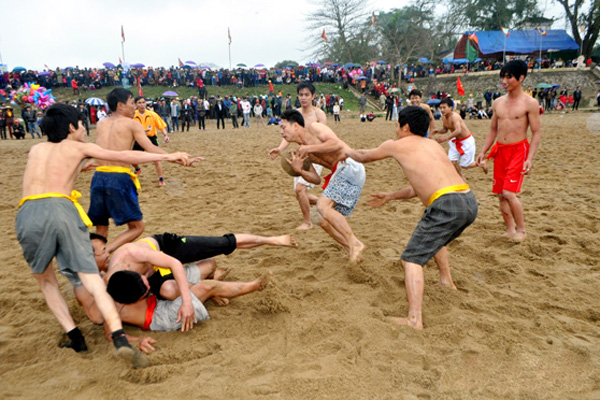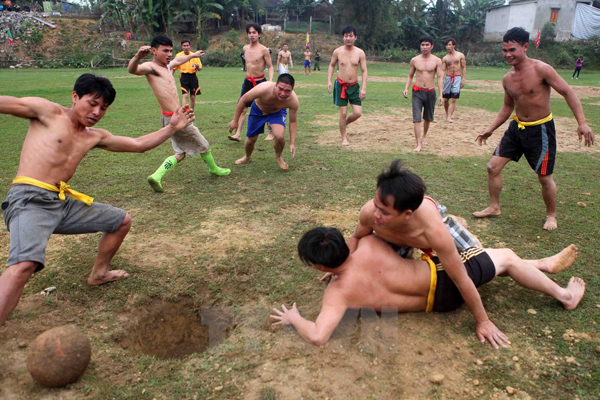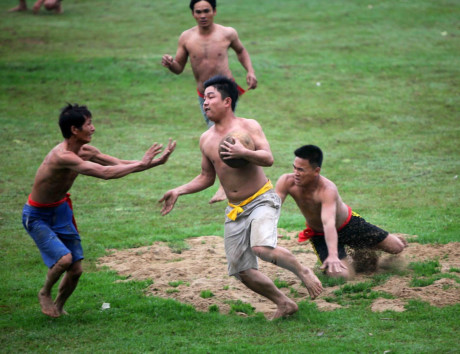The rhythmic sound of a drum echoes for kilometers-vibrating, pressing, increasing in urgency. Any spectators arriving late from neighbouring villages hasten along their way. The crowd grows larger and larger around a flat piece of empty space in front of the village pagoda.
The rhythmic sound of a drum echoes for kilometers-vibrating, pressing, increasing in urgency. Any spectators arriving late from neighbouring villages hasten along their way. The crowd grows larger and larger around a flat piece of empty space in front of the village pagoda.
Suddenly, the drum stops. Then it resumes, but this time in three long series and accompanied by the metallic sound of a gong. Three respectable old men in long blue robes with puffed sleeves appear. The man in the middle holds a multi-coloured flag; the man on the right, a small drum; and the man on the left, a gong. These are the referees. Behind them come two teams of twenty players each. These young, well-built men are barebacked, with colourful loincloths and red or yellow belts designating their team. The captain of one team holds a tray with a ball on it, covered with a pink cloth.
The referees and players stop once they reach the centre of the playing area. The team leader places the tray on the ground, lifts the pink cloth and delicately places the "ball" in a hole dug in the middle of the playing field. The ball (cu) is made from the root of a banana tree and is twice as large as a football. It weighs four to five kilograms.

Organisers have already dug two goals-holes from 50cm to 60cm deep-at the two ends of the field. During the game, players must catch the ball, as in rugby, and throw it into the goal. Once a player has caught the ball, he may run or pass it to a team-mate. But unlike rugby or soccer, the ball may not touch the players' feet. A single goal wins the match.
This particular match is about to start: The two teams move to the middle of the field. There are no fixed positions. The drum and the gong strike their last notes. With this, a member of the red team passes the ball to a team-mate, who pushes past one, two then three opponents. But a fourth player relentlessly blocks him and grabs the ball. The "yellow" team runs, heading for its goal. The yellows soon regroup to protect the ball. Like fencers en graded, with bent knees and arms stretching forward, they are ready to deal with any opponents who want to interfere.

But the "reds" reorganise and counter-attack. Around ten red players worm themselves into the yellows' defending circle. Then go a collective struggle to possess the ball. Within several seconds, the ball passes back to the reds. They are now in the offensive position and make a lightning attack towards their goal. But they fail. A "yellow" runs even faster and prevents the score. The game continues amidst struggling arms and legs. As the competition grows heated, someone suddenly throws the ball dozens of steps away from the players. A red retrieves the ball and, before any of the yellows can react, races towards his goal. After some quick passing, in the blink of an eye, the ball lies in the reds' goal. Cries, applause, and the sound of the drum and gong bring the players back to reality: The reds have won.
This game requires speed, skill, strength and daring. General Pham Ngu Lao, the "right arm" of Vietnam's great general Tran Hung Dao, invented vat cu (literally, "ball wrestling") in the 13th century to train his soldiers to defeat the Mongol invaders. Like many uniquely Vietnamese sports, vat cu almost disappeared during the French occupation. However, the National Sports Committee has studied the game's original rules and is trying to revive the game. Without doubt, vat cu has returned to become one of the most popular games at Lunar New Year festivals.



